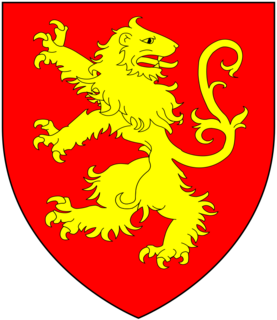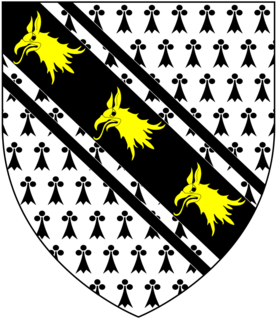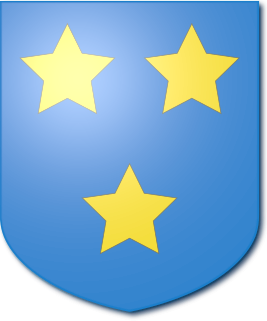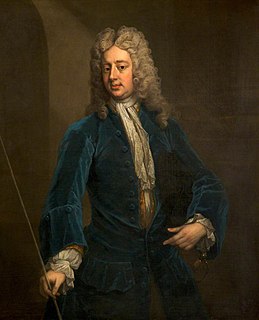
The Ashurst Baronetcy, of Waterstock in the County of Oxford, was a title in the Baronetage of England. It was created on 21 July 1688 for Henry Ashurst, Member of Parliament for Truro and Wilton. The second Baronet represented Windsor in Parliament. The title became extinct on his death in 1732.
Sir James Ashe, 2nd Baronet was an English baronet and Whig politician who sat in the House of Commons from 1701 to 1705.

The Morice Baronetcy, of Werrington in the County of Devon, was a title in the Baronetage of England.

The Baronetcy of Gresley of Drakelow was created in the Baronetage of England on 29 June 1611 for George Gresley of Drakelow Hall, Derbyshire who was later High Sheriff of Derbyshire and Member of Parliament for Newcastle-under-Lyme.
Knypersley Hall is an 18th-century Georgian style country mansion at Biddulph, Staffordshire, England. It is protected as a Grade II* Listed building. After falling into a state of disrepair it was partially subdivided into residential apartments, although the Hall was not wholly restored at this point and was falling into further disrepair. However, the current owner has restored, repaired and divided into three separate residential dwellings - Knypersley Hall, East View and West View which complement the remainder of the original buildings which were part of the original Hall Estate.

The Yonge Baronetcy, of Culliton in the County of Devon, was a title in the Baronetage of England. It was created on 26 September 1661 for the merchant and Member of Parliament, John Yonge. He was succeeded by his son Walter, the second Baronet. He was also a Member of Parliament. His son, the third Baronet, sat in the House of Commons for more than a quarter of a century. On his death the title passed to his son, the fourth Baronet. He was also a politician and served as Secretary at War. He is also remembered for his diaries. He was succeeded by his son, the fifth Baronet. Like his father he served as Secretary at War and was also Governor of the Cape Colony. The baronetcy became extinct on his death in 1812.
Sir John Bowyer, 1st Baronet was a 17th-century English soldier and politician.

The Hildyard Baronetcy, of Patrington in the County of York, was a title in the Baronetage of England. It was created on 25 June 1660 for Robert Hilyard, of Patrington and Winestead. The ancient Hildyard family is thought to have been of Norman origin. Robert Hildyard served as Gentleman of the Bedchamber to King Charles I of England and was a major-general in the King's army during the English Civil War. He took part in the Battle of Marston Moor. He was raised to a baronetcy by Charles II following the Restoration of the Monarchy. He was succeeded by his grandson Sir Robert Hildyard, 2nd Baronet, a Member of Parliament for Hedon. He was succeeded by his nephew, the third Baronet, who was Member of Parliament for Great Bedwyn. The latter's son, the fourth Baronet, was High Sheriff of Yorkshire in 1783. On his death in 1814 the baronetcy became extinct.
Sir John Bowyer, 2nd Baronet was an English politician.
Sir Henry Puckering, 3rd Baronet was an English royalist and politician.

Sir John Morton, 2nd Baronet of Milbourne St Andrew in Dorset, was an English landowner and politician who sat in the House of Commons between 1661 and 1695.
Sir William Williams, 6th Baronet of Faenol (Vaynol) was a Welsh politician and landowner elected as MP for Caernarvonshire from 1689 until his death.

Sir John Stonhouse, 3rd Baronet (c.1672–1733) was an English landowner and Tory politician who sat in the English and then British House of Commons from 1701 to 1733.

Sir Ralph Cole, 2nd Baronet was an English politician.

The Blount Baronetcy, of Tittenhanger in the County of Hertford, was created in the Baronetage of England on 27 January 1680 for Thomas Pope Blount. In the 16th century Elizabeth Blount, daughter of Sir Walter Blount of Blount Hall, Staffordshire, married Sir Thomas Pope of Tittenhanger, Herefordshire. Her nephew Sir Thomas Pope Blount inherited the estate at Tittenhanger on her death. The first Baronet was the grandson of Sir Thomas and son of the traveller Sir Henry Blount. He represented St Albans and Hertfordshire in the House of Commons. The title became extinct on the death of his grandson, the third Baronet, in 1757.

The Assheton Baronetcy, of Lever in the County of Lancaster, was created in the Baronetage of England on 28 June 1620 for Ralph Assheton. The second Baronet sat as Member of Parliament for Clitheroe. The title became extinct on the death of the fourth Baronet in 1696.

The Bridgeman baronetcy, of Ridley in the County of Chester, was created on 12 November 1673 for Orlando Bridgeman, Member of Parliament for Horsham and younger son of the 1st Baronet, of the Great Lever creation. He was succeeded by his son, the 2nd Baronet. The latter was Member of Parliament for Calne, Lostwithiel, Blechingley and Dunwich.
The Howe Baronetcy, of Cold Barwick in the County of Wiltshire, was created in the Baronetage of England on 20 June 1660 for George Grobham Howe, Member of Parliament for Hindon in 1660–1667. His son Sir James Howe, 2nd Baronet was also MP for Hindon.

The Howe Baronetcy, of Compton in the County of Gloucester, was created in the Baronetage of England on 22 September 1660 for John Howe, Member of Parliament for Gloucestershire in 1654–1655 and 1656–1658. His elder son Richard, the second baronet, was also an MP, as was his younger son John Grobham Howe. Sir Richard Grobham Howe, the third baronet, was MP for Tamworth, Cirencester and Wiltshire. Sir Emanuel Scrope Howe, 4th Baronet became the 2nd Viscount Howe on the death of his father in 1713 and the baronetcy which he inherited in 1730 was merged with his viscountcy.

The Stapylton baronetcy, or Stapleton, of Myton in Yorkshire, was created in the Baronetage of England on 22 June 1660 for Henry Stapylton.













